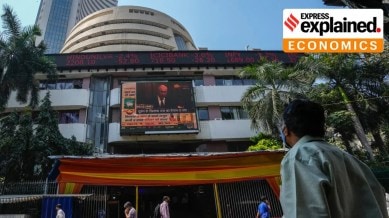The unfolding “correction” in India’s stock indices — the Nifty50 has shed a tenth of its end-September peak — has been linked to the build-up to the Chinese government stimulus to boost its flagging economy.
After Beijing announced its first stimulus package in late September, foreign investors offloaded Indian shares to pick up Chinese equities that were trading at much lower price-earnings multiples (making Chinese stocks more attractive from a valuation perspective).
The slide in the bourses has persisted — even though domestic money has continued to pour into India’s stocks. Last week, the Chinese government announced a second booster shot for its economy.
Some other global factors too, are responsible for the current selloff in the Indian markets — these include the anticipated protectionist turn in the United States under Donald Trump, the impact of high tariff barriers on the policy stance of the Federal Reserve, and the expected rate hike by the Bank of Japan in its December meeting, which has triggered an unwinding of yen carry-trade positions across markets.
However, the impact of the two Chinese stimulus packages on investors and markets has been underwhelming so far. So why this reaction by India’s indices?
Chinese stimulus packages
On September 24, China’s central bank, the People’s Bank of China, unveiled measures to boost the economy, which included cutting the amount of cash banks must hold in reserve, smaller down payments for home purchases, and tax incentives for new home buyers. The FPI selloff in the Indian markets began soon afterward.
Story continues below this ad
On November 8, the Chinese government approved a massive 10-trillion-yuan ($1.4 trillion) plan to revive its domestic economy and enable provincial governments to refinance piled-up debt.
These measures appeared even more relevant after Trump’s election last week — and have triggered anticipation of an even bigger stimulus package.
Should the President-elect follow through on his campaign promise of imposing a 60% tariff on Chinese goods, more than 2 percentage points could be shaved off China’s growth over the next year, analysts believe.
A $1.4-tn disappointment
The two economic stimulus measures announced in the space of six weeks, however, did little by way of offering direct support to catalyse consumer spending. A property downturn, surging government debt, and rising unemployment and falling consumption, have slowed down China’s growth since the Covid-19 pandemic.
Story continues below this ad
The plan announced on Friday is merely a form of debt relief for local governments. A lot of the growth in China in recent years has been driven by real estate sales, and the collapse of the property market a couple of years ago cut off that source of funds for local governments. Since these governments have traditionally invested heavily in infrastructure, they are struggling with the interest on the accumulated debt. Local authorities have now been allowed to create new bonds and consolidate their debts to bring down the servicing cost.
However, there has been no new measure to directly boost domestic demand so far. This has been a challenge for China’s policymakers as consumers have become increasingly spending-averse. While the Chinese have traditionally had a very high savings rate, the returns on those savings, mostly tied up in property, have plummeted. Following crises such as the bankruptcies of real estate giants like Evergrande, consumers are now reluctant to spend. Boosting consumer sentiment would need more of a direct, spending-focused stimulus than the two packages announced so far.
Chinese stocks over India’s
So why are FPIs dumping stocks in countries such as India and lining up for China? There could be three broad reasons.
MORE BOOSTERS LIKELY: China’s Finance Minister Lan Foan said on November 8 that more stimulus was on the way, amid speculation that Beijing may not want to exhaust all its firepower before Trump enters the Oval Office in January. Nomura anticipates the eventual scale of China’s fiscal stimulus package to reach 2-3% of GDP annually over the next several years.
Story continues below this ad
According to a report by the Financial Times, Trump has asked trade hawk and protectionist Robert Lighthizer to return as US Trade Representative, the position from which he led the first Trump administration’s trade war against China. The consolation for Beijing is that Elon Musk, Trump’s choice to co-lead the new Department of Government Efficiency, is likely to be something of a middleman for US-China business relations, given his significant exposure to the Chinese market through the operations of his company, Tesla, there.
POOR INDIA INC. EARNINGS: FPIs would also be looking at India’s high stock valuations and the disappointing recent earnings season.
From higher prices of commodities to rising expenses on employees, operating margins of Indian companies have come under strain at a time of muted revenue growth. Revenues of a group of 424 companies (excluding banks, financials and oil marketing companies) that announced results for Q2FY25 grew at a modest 6% year-on-year. At the same time, total expenditure rose by 7%, leading to an 80-basis point fall in operating margins y-o-y.
Also, as interest costs increased by more than 10%, net profits were up just 4% y-o-y for these companies.
Story continues below this ad
TRUMPONOMICS: Trump 2.0 could mean a challenge for India to balance its growth stability amid trade and tariff wars, supply-chain disruptions, and heightened forex volatility.
Trump’s proposed tax-relief, tariff-hike, and immigration-control measures could stoke inflation in the US and disrupt the Fed’s rate-cut agenda. This would impact the trajectory of India’s monetary policy if the Reserve Bank of India decides to resolve the uncertainties before undertaking any significant action. Analysts have said a December rate-cut is pretty much ruled out — and the 14-month-high retail inflation in October could mean any such action could be pushed further into the next year.
